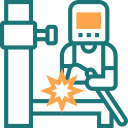"*" indicates required fields

Between 1980 and 2002 in Queensland alone there were over 4,500 admissions to the hospital for burns injuries. Of those injuries, 56% were as a result of flame burns, 26% scald burns, 9% contact burns, 5% chemical burns, 2% electrical burns, and the remaining were as a result of friction and flash burns. 20% of those burns happened whilst at work and 13% as a result of motor vehicle accidents.
Burn injuries can have a significant impact on an individual’s ability to work, their home situation, and social life. If you have sustained a burn or chemical burn injury at work or on the road then you may be entitled to an injury compensation claim.
Our burn injury compensation experts can provide free and no obligation initial consultation advice on your situation, so you understand your rights and legal options to move forward. We serve clients across Queensland from our Brisbane office and all claims are done on a no win, no fee basis which means no upfront costs.

Common causes of injuries are as follows:
Burn injuries can be classified by degrees of severity. Burn degrees include:
Generally, burns that cover greater than 10% of the total body surface area are considered a major burn injury.
Burns can cause a wide variety of injuries. Injuries can range from mild to severe with some symptoms developing hours after the initial injury. Depending on the degree of the burn, some of the symptoms experienced after burns include the following:
It is recommended that you seek medical assistance if you experience the following:
In Australia and New Zealand between 2009 and 2016 it was found that 17% of burn injuries were as a result of work related burns. Of those, 33% of the injuries were as a result of flames, 30% were as a result of scalding and 17% were chemical burn injuries. Additionally, between 2018-2019, of the accepted worker’s compensation claims where the injured worker did not return to work for a week or more, 2% of those involved burn injuries (made up of heat, electricity, and or chemical burns).
These do not include burn injuries that were not reported or where the worker went back to work after one week. Unfortunately, the figure is likely to be much higher than recorded as some injuries are not reported or workers cannot afford to be off work for a week or more.

Some of the professions most at risk of receiving severe burn injuries include (but aren’t limited to) the following:

If you've suffered from a chemical burn at work due to negligence such as insufficient safety systems or training then we may be able to assist you claim for work injury compensation. A chemical burn can be incredibly painful and depending on the severity can cause permanent and long term damage to your skin, eyes, and/or respiratory system. This occurs when you come into contact with strong chemicals or when toxic fumes are inhaled, causing damage to internal organs.
Depending on the degree of the burn, some symptoms that can be experienced after a chemical burn are as follows:
Where chemicals have been inhaled or swallowed individuals may experience the following symptoms:
In more severe cases, symptoms can include:
If you believe you are suffering from any of the above symptoms it is vital that you seek medical treatment from a doctor.
Some of the professions most at risk of receiving severe chemical burns and inhaling toxic chemicals include (but again is not limited to) the following:

Your employer has a responsibility to provide workers with a safe environment (including training, appropriate personal protective equipment (‘PPE’) and support). Employers must minimise your risk of sustaining a burn injury. For example, placing warning signs on hot surfaces, providing heat resistant PPE, implementing routine safety checks, ensuring workers are adequately trained in relevant procedures and policies.
If you have suffered a burn injury at work, you could be entitled to claim worker’s compensation with WorkCover Queensland or a self-insurer (if your employer is self-insured).
The first step to take if you have suffered a burn injury at work is to seek medical attention. Once sought, you should contact your workplace (if they don’t already know) that you have been injured at work.
If you have sought medical attention, it is best to get your doctor to complete a worker’s compensation certificate. This will allow you to lodge a worker’s compensation claim with WorkCover Queensland.
There are many ways that you can lodge a worker’s compensation claim:
You have six (6) months from the date of your accident to lodge a worker’s compensation claim.
Once lodged, WorkCover has 20 business days to inform you as to whether they have accepted or rejected your claim.
If your claim is accepted you will be entitled to reimbursement of medical expenses, weekly compensation to cover time off work, medical treatment, assistance getting back to work and support during your claim.
Once your injury has become stable an assessment can be made to identify whether you will suffer any permanent impairments because of the injury. The election can be made by you or WorkCover. This process involves you being assessed by a medical expert who (based on your injuries) gives you a degree of permanent impairment (‘DPI’). WorkCover then uses this DPI to calculate a lump sum offer.
Once received, you can choose to request a second medical opinion, accept the offer (foregoing any future ability to pursue a claim against your employer) or reject the offer and pursue a common law claim.
If you have suffered a burn injury at work, we encourage you to speak to one of our expert personal injury lawyers to identify your legal options and explain the claim process.
If your injury was caused by your employers’ negligence (for instance they didn’t provide the correct PPE, didn’t conduct the proper safety checks or was otherwise negligent) you may consider pursuing a common law claim against your employer.
If you pursue a common law claim against your employer, you need to show fault. This essentially means that you need to show that your employer caused your injuries.
If you pursue a common law claim you are able to make a claim for damages for:
If you believe that your burn injury was caused by your employers’ negligence and have been unable to return to work or are working in a reduced capacity, we encourage you to contact our firm to understand your legal options.

If you have been in a car accident, were not at fault, and suffered a burn injury you are entitled to receive compensation. Burn injuries suffered after an accident can impact your ability to return to work and function in your daily life.
If you have suffered a burn injury as a result of a car accident, contact one of our expert personal injury lawyers to find out what your legal options are.
If you have suffered a burn injury as a result of a car accident, you are entitled to lodge a claim with the CTP insurer of the vehicle at fault.
In order to do so you must report the accident to the police (if not notified already) by completing a Report of Traffic Incident to Police form, obtain the registration/details of the vehicle at fault and who their CTP insurer is and complete a Notice of Accident Claim form and lodge that form and any accompanying records the CTP insurer. We can assist you with completing the notice of accident claim form which differs for non-fatal and fatal car accident claims.
You must submit this form within nine (9) months of the accident. If the at-fault driver was not registered, you must submit a claim form to the Nominal Defendant within three (3) months after an accident.
If you wish to pursue a claim for damages, we encourage you to contact our expert team of personal injuries lawyers for advice about your legal options.

As touched on above, a claim for damages will take into account the following:
The final assessment of damages will depend on the severity of the burn injury, the impact it is having on your ability to work, how much treatment you will need in the future and any care you may require in the future.
Each claim is different and each assessment of how much you may be able to claim will be dependent on varying factors.
We encourage you to contact our expert personal injury firm to discuss the possibility of commencing a claim for damages for your injuries and what your legal options may be.

It is important that you are aware that there are time limitations in place for commencing a claim for compensation.
In order to pursue a common law compensation claim, you have to do so within three (3) years of the date you were injured. This involves filing appropriate documents in the court. If you do not do so within the relevant time limitation you will lose all rights to pursue a claim.
It is incredibly important that you speak with a lawyer if you have suffered a burn injury and wish to pursue a claim. We encourage you to speak to our expert personal injury team today and find out what legal options you have.